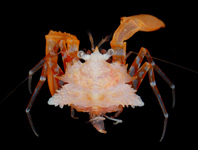Abstract
Patagurus rex gen. et sp. nov., a deep-water pagurid hermit crab, is described and illustrated based on a single specimen dredged from 400 m off Moorea, Society Islands, French Polynesia. Patagurus is characterized by a subtriangular, vaulted, calcified carapace, with large, wing-like lateral processes, and is closely related to two other atypical pagurid genera, Porcellanopagurus Filhol, 1885 and Solitariopagurus Türkay, 1986. The broad, fully calcified carapace, calcified branchiostegites, as well as broad and rigidly articulated thoracic sternites make this remarkable animal one of the most crab-like hermit crabs. Patagurus rex carries small bivalve shells to protect its greatly reduced pleon. Carcinization pathways among asymmetrical hermit crabs and other anomurans are briefly reviewed and discussed.

